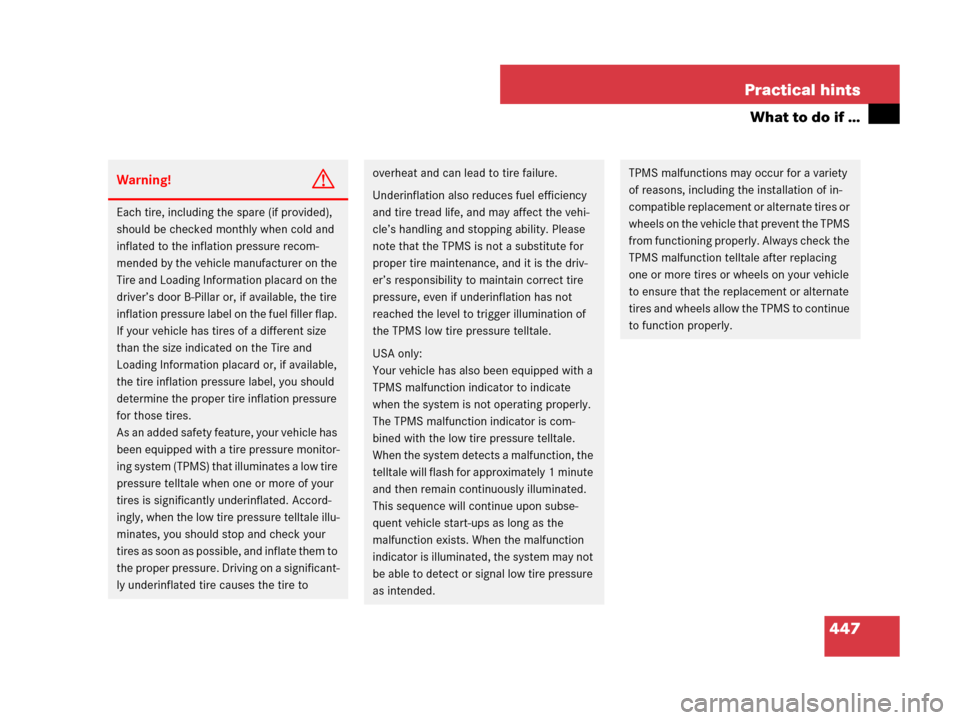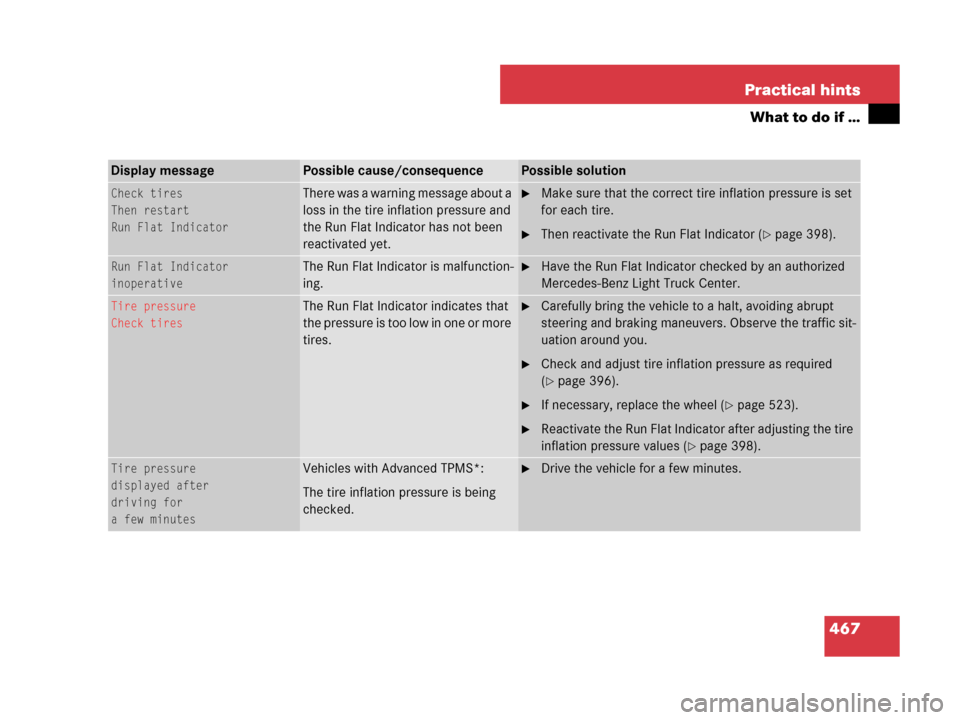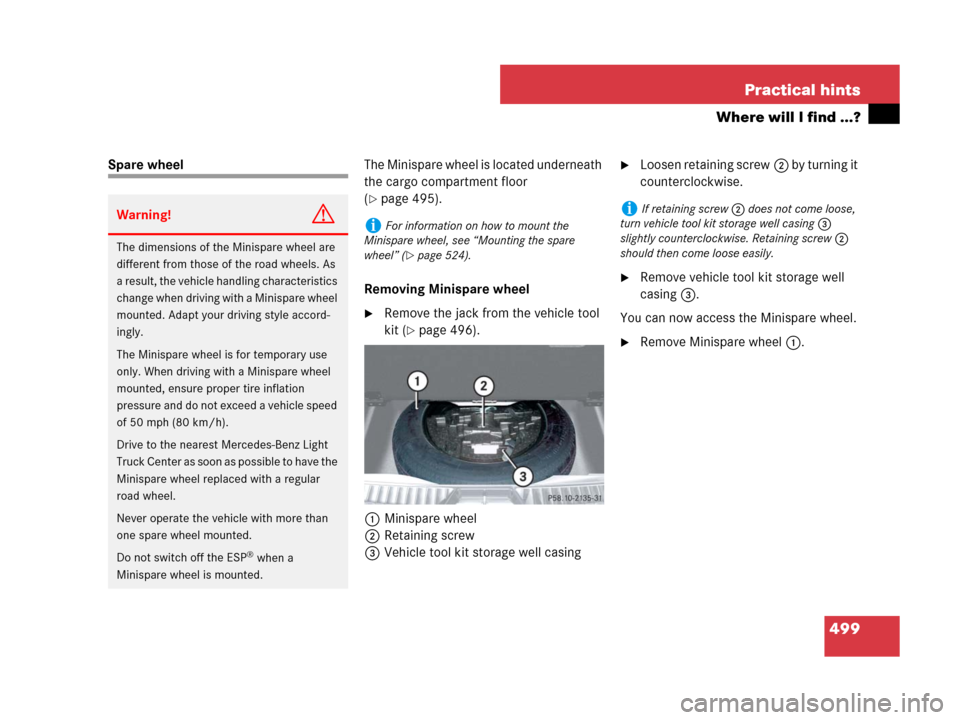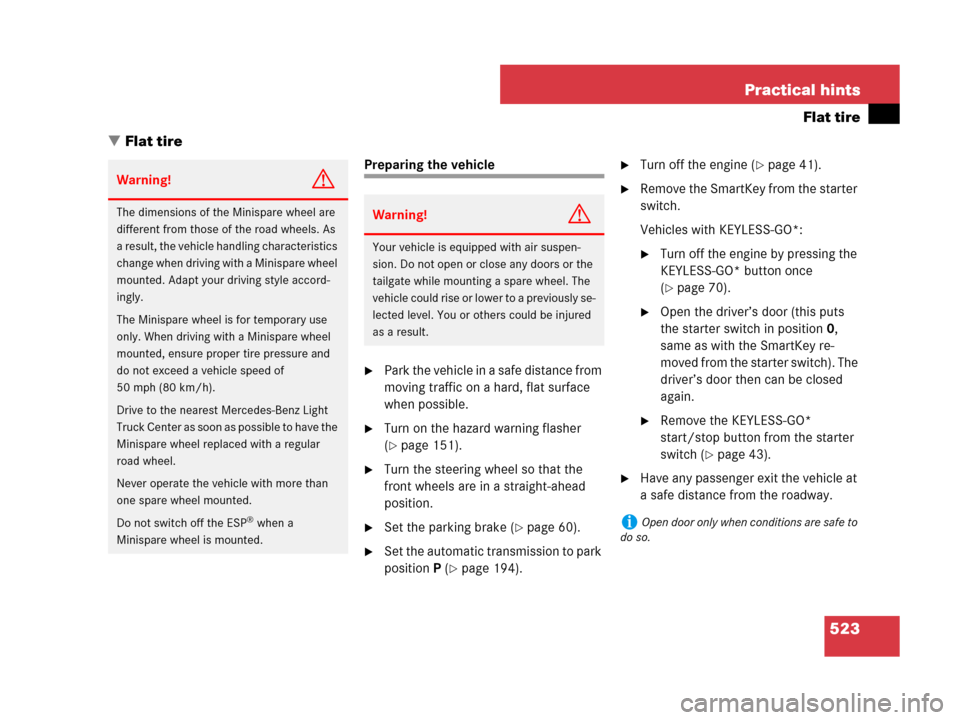Page 436 of 595
435 Practical hints
What to do if …
Where will I find ...?
Unlocking/locking in an emergency
Opening/closing in an emergency
Resetting activated head restraints
Replacing SmartKey batteries
Replacing bulbs
Replacing wiper blades
Flat tire
Bleeding the fuel system
(diesel engine only)
Battery
Jump starting
Towing the vehicle
Fuses
Page 447 of 595

446 Practical hints
What to do if …
ProblemPossible cause/consequenceSuggested solution
HUSA only:
Combination low tire pres-
sure/TPMS malfunction telltale
for the TPMS illuminates contin-
uously.
Canada only:
Low tire pressure telltale for the
Advanced TPMS* illuminates
continuously.The TPMS (USA only) or Advanced TPMS*
(Canada only) detects a loss of pressure in
at least one tire.�Carefully bring the vehicle to a halt,
avoiding abrupt steering and braking
maneuvers. Observe the traffic situation
around you.
�Read and observe messages in the
multifunction display.
If the tire inflation pressure in the respec-
tive tire(s) has (have) been corrected, the
combination low tire pressure/TPMS mal-
function telltale goes out after few minutes
driving.
HUSA only:
Combination low tire pres-
sure/TPMS malfunction telltale
for the TPMS flashes
60 seconds and then stays
illuminated.There is a malfunction in the TPMS.�Read and observe messages in the
multifunction display.
�Have the TPMS checked by an
authorized Mercedes-Benz Light Truck
Center.
After the malfunction has been remedied
the combination low tire pressure/TPMS
malfunction telltale goes out after few
minutes driving.
Page 448 of 595

447 Practical hints
What to do if …
Warning!G
Each tire, including the spare (if provided),
should be checked monthly when cold and
inflated to the inflation pressure recom-
mended by the vehicle manufacturer on the
Tire and Loading Information placard on the
driver’s door B-Pillar or, if available, the tire
inflation pressure label on the fuel filler flap.
If your vehicle has tires of a different size
than the size indicated on the Tire and
Loading Information placard or, if available,
the tire inflation pressure label, you should
determine the proper tire inflation pressure
for those tires.
As an added safety feature, your vehicle has
been equipped with a tire pressure monitor-
ing system (TPMS) that illuminates a low tire
pressure telltale when one or more of your
tires is significantly underinflated. Accord-
ingly, when the low tire pressure telltale illu-
minates, you should stop and check your
tires as soon as possible, and inflate them to
the proper pressure. Driving on a significant-
ly underinflated tire causes the tire to
overheat and can lead to tire failure.
Underinflation also reduces fuel efficiency
and tire tread life, and may affect the vehi-
cle’s handling and stopping ability. Please
note that the TPMS is not a substitute for
proper tire maintenance, and it is the driv-
er’s responsibility to maintain correct tire
pressure, even if underinflation has not
reached the level to trigger illumination of
the TPMS low tire pressure telltale.
USA only:
Your vehicle has also been equipped with a
TPMS malfunction indicator to indicate
when the system is not operating properly.
The TPMS malfunction indicator is com-
bined with the low tire pressure telltale.
When the system detects a malfunction, the
telltale will flash for approximately 1 minute
and then remain continuously illuminated.
This sequence will continue upon subse-
quent vehicle start-ups as long as the
malfunction exists. When the malfunction
indicator is illuminated, the system may not
be able to detect or signal low tire pressure
as intended.TPMS malfunctions may occur for a variety
of reasons, including the installation of in-
compatible replacement or alternate tires or
wheels on the vehicle that prevent the TPMS
from functioning properly. Always check the
TPMS malfunction telltale after replacing
one or more tires or wheels on your vehicle
to ensure that the replacement or alternate
tires and wheels allow the TPMS to continue
to function properly.
Page 468 of 595

467 Practical hints
What to do if …
Display messagePossible cause/consequencePossible solution
Check tires
Then restart
Run Flat IndicatorThere was a warning message about a
loss in the tire inflation pressure and
the Run Flat Indicator has not been
reactivated yet.�Make sure that the correct tire inflation pressure is set
for each tire.
�Then reactivate the Run Flat Indicator (�page 398).
Run Flat Indicator
inoperativeThe Run Flat Indicator is malfunction-
ing.�Have the Run Flat Indicator checked by an authorized
Mercedes-Benz Light Truck Center.
Tire pressure
Check tiresThe Run Flat Indicator indicates that
the pressure is too low in one or more
tires.�Carefully bring the vehicle to a halt, avoiding abrupt
steering and braking maneuvers. Observe the traffic sit-
uation around you.
�Check and adjust tire inflation pressure as required
(
�page 396).
�If necessary, replace the wheel (�page 523).
�Reactivate the Run Flat Indicator after adjusting the tire
inflation pressure values (
�page 398).
Tire pressure
displayed after
driving for
a few minutesVehicles with Advanced TPMS*:
The tire inflation pressure is being
checked.�Drive the vehicle for a few minutes.
Page 489 of 595
488 Practical hints
What to do if …
Display symbolDisplay messagesPossible cause/consequencePossible solution
HTire pressure
Check tiresThe pressure is too low in one or
more tires.�Check and correct tire inflation pressure as
required.
Tire pressure
Caution - tire defectOne or more tires are deflating.�Carefully bring the vehicle to a halt, avoiding
abrupt steering and braking maneuvers.
�If necessary, change the wheel.
Caution - tire defectVehicles with Advanced TPMS*:
One or more tires are deflating.
The respective tire is shown in the
multifunction display.�Carefully bring the vehicle to a halt, avoiding
abrupt steering and braking maneuvers.
�If necessary, change the wheel.
Warning!G
Do not drive with a flat tire. A flat tire affects
the ability to steer or brake the vehicle. You
may lose control of the vehicle. Continued
driving with a flat tire will cause excessive
heat build-up and possibly a fire.
Page 490 of 595
489 Practical hints
What to do if …
Display symbolDisplay messagesPossible cause/consequencePossible solution
HTire pressure
Check tiresThe tire pressure in one or more tires is
already below the minimum value.�Carefully bring the vehicle to a halt,
avoiding abrupt steering and braking
maneuvers.
�Check and adjust tire pressure as
required.
�If necessary, change the wheel.
Check tiresVehicles with Advanced TPMS*:
The tire pressure in one or more tires is
already below the minimum value.
The respective tire is shown in the
multifunction display.�Carefully bring the vehicle to a halt,
avoiding abrupt steering and braking
maneuvers.
�Check and adjust tire pressure as
required.
�If necessary, change the wheel.
Warning!G
Do not drive with a flat tire. A flat tire affects
the ability to steer or brake the vehicle.
You may lose control of the vehicle. Contin-
ued driving with a flat tire will cause exces-
sive heat build-up and possibly a fire.
Page 500 of 595

499 Practical hints
Where will I find ...?
Spare wheelThe Minispare wheel is located underneath
the cargo compartment floor
(
�page 495).
Removing Minispare wheel
�Remove the jack from the vehicle tool
kit (
�page 496).
1Minispare wheel
2Retaining screw
3Vehicle tool kit storage well casing
�Loosen retaining screw2 by turning it
counterclockwise.
�Remove vehicle tool kit storage well
casing3.
You can now access the Minispare wheel.
�Remove Minispare wheel1.
Warning!G
The dimensions of the Minispare wheel are
different from those of the road wheels. As
a result, the vehicle handling characteristics
change when driving with a Minispare wheel
mounted. Adapt your driving style accord-
ingly.
The Minispare wheel is for temporary use
only. When driving with a Minispare wheel
mounted, ensure proper tire inflation
pressure and do not exceed a vehicle speed
of 50 mph (80 km/h).
Drive to the nearest Mercedes-Benz Light
Truck Center as soon as possible to have the
Minispare wheel replaced with a regular
road wheel.
Never operate the vehicle with more than
one spare wheel mounted.
Do not switch off the ESP
® when a
Minispare wheel is mounted.
iFor information on how to mount the
Minispare wheel, see “Mounting the spare
wheel” (
�page 524).
iIf retaining screw2 does not come loose,
turn vehicle tool kit storage well casing3
slightly counterclockwise. Retaining screw2
should then come loose easily.
Page 524 of 595

523 Practical hints
Flat tire
�Flat tire
Preparing the vehicle
�Park the vehicle in a safe distance from
moving traffic on a hard, flat surface
when possible.
�Turn on the hazard warning flasher
(
�page 151).
�Turn the steering wheel so that the
front wheels are in a straight-ahead
position.
�Set the parking brake (�page 60).
�Set the automatic transmission to park
positionP (
�page 194).
�Turn off the engine (�page 41).
�Remove the SmartKey from the starter
switch.
Vehicles with KEYLESS-GO*:
�Turn off the engine by pressing the
KEYLESS-GO* button once
(
�page 70).
�Open the driver’s door (this puts
the starter switch in position0,
same as with the SmartKey re-
moved from the starter switch). The
driver’s door then can be closed
again.
�Remove the KEYLESS-GO*
start/stop button from the starter
switch (
�page 43).
�Have any passenger exit the vehicle at
a safe distance from the roadway.
Warning!G
The dimensions of the Minispare wheel are
different from those of the road wheels. As
a result, the vehicle handling characteristics
change when driving with a Minispare wheel
mounted. Adapt your driving style accord-
ingly.
The Minispare wheel is for temporary use
only. When driving with a Minispare wheel
mounted, ensure proper tire pressure and
do not exceed a vehicle speed of
50 mph (80 km/h).
Drive to the nearest Mercedes-Benz Light
Truck Center as soon as possible to have the
Minispare wheel replaced with a regular
road wheel.
Never operate the vehicle with more than
one spare wheel mounted.
Do not switch off the ESP
® when a
Minispare wheel is mounted.
Warning!G
Your vehicle is equipped with air suspen-
sion. Do not open or close any doors or the
tailgate while mounting a spare wheel. The
vehicle could rise or lower to a previously se-
lected level. You or others could be injured
as a result.
iOpen door only when conditions are safe to
do so.